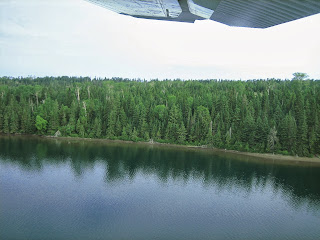Houghton really is a college town, home to Michigan Tech University.
The Keweenaw Peninsula was also very big in terms of copper mining back in the day, and as I pointed out in my SHADOWS post last week, you can still visit the old Quincy Copper Mine and Hoist. After a day of touring around (or to give you that necessary jumpstart), you can't go wrong with a great cuppa at the Cyberia Café,
whose owner was nice enough to open up early for a caffeine-deprived writer AND let her hang out on his internet because hers wasn't working. And that brownstone synagogue Tom talks about near the end? Yup, Temple Jacob, with its very beautiful copper dome, is there, too--
to the right of the lift bridge.
Michigan Tech's real claim to fame is that the university's home to the Isle Royale Wolf and Moose Project, the longest running, continuous study of predator-prey populations in the world. Over forty miles long, Isle Royale is isolated and remote, the largest island in the largest inland lake in the world, and a place you really have to want to get to. Most people come by ferry (about 5 1/2 hours from Houghton, 1 1/2 from Thunder Bay, Ontario, or 3 hours and change from Grand Portage, MN),
or--if you can scrape together the change and spring for it--about 45 minutes from Houghton by seaplane (after a 5 1/2 hour drive to the town).
There is nothing on Isle Royale other than a very small National Park Service lodge (with a grill and tiny restaurant), a lookout tower, a former fish farm (and a place that Rolf Peterson, one of Isle Royale's premiere wolf researchers, calls home)
some cottages from the days before the island was made a national park,
a couple water taxis, the research station (on the southwestern tip of this forty-mile long island), and a whole lot of backcountry with some of the most spectacular scenery and fabulous flora and fauna you'll ever see.
Why do research here? In brief, the island's home to a number of isolated populations, and research has focused on moose and wolf populations, beginning back in the 1950s. Now, moose can swim between the mainland and the island, but wolves can't. So how did they get there in the first place? Ice bridges: Lake Superior typically freezes over at least a few days every year, although the thickness of this ice varies from a few centimeters to several inches (enough to support vehicles on an "ice highway" between Bayfield, WI and Madeline Island). Animals can cross ice bridges if they're thick enough, which is how the wolves got to the island in the first place. Unfortunately for them, the last ice bridge anywhere thick enough existed between Thunder Bay and the island happened in 1985. So the wolves are trapped, making them a pretty interesting population for study, and one that's been as high as 24 individuals in three different packs to where they are now: just eight wolves, in two packs, with a single female in a three wolf pack (The West End Trio), another three wolf pack (Chippewa Harbor) and two loners (one of which might be a female). There's been lots of debate on whether or not we ought to interfere to save the population. In a way, we already have; the wolves were decimated by parvovirus brought over by a tourist's (illegal) dog; and in 2012, a stunning seven wolves (including a female) died, three of them after falling into an abandoned copper mine shaft that has since been closed off. So things have looked pretty bleak for the wolves. As I recall, either no pups were born or survived as of two years ago--but researchers at Michigan Tech have recorded evidence of a few pups this past year. Study on these populations is year-round, but the most fruitful time for wolf study is during the winter, when there's no one on the island other than the researchers; Jon Vucetich, a wildlife ecology from Michigan Tech, leads the team and did a lovely series of blog entries on the research for the New York Times in 2012.
On the other hand, if you ever want to get into the act, you can volunteer to scrounge for moose bones during the Summer Research Season (but bring plenty of mosquito repellant).
Me, I just like to lace up the boots and hit the trails.
Because really, with vistas like this, no wonder Peter decided that, for him, this was heaven on Earth.























1 comment:
Stunning photos. Would make a great setting in a book. Thanks for sharing. Reminds me of Alaska.
Post a Comment